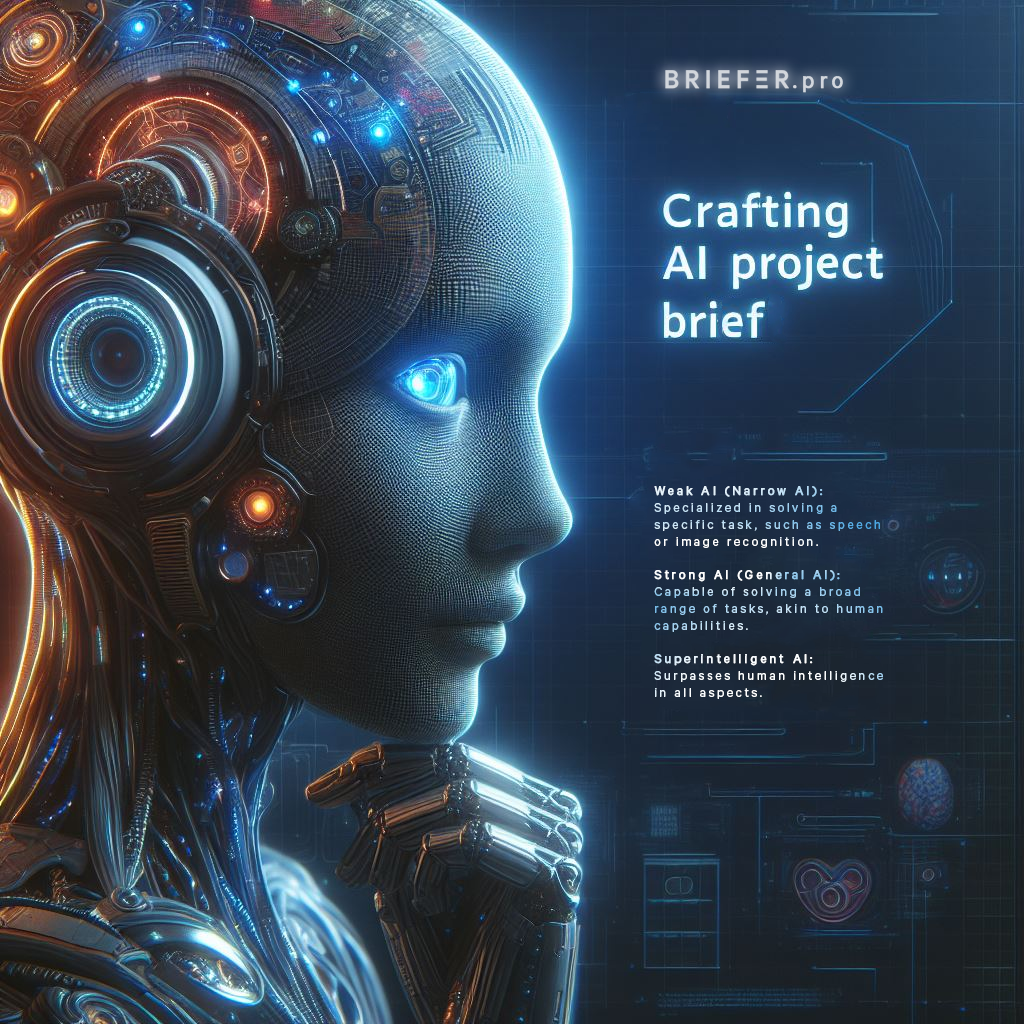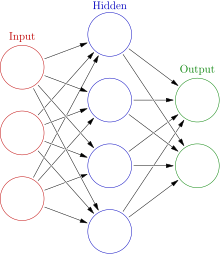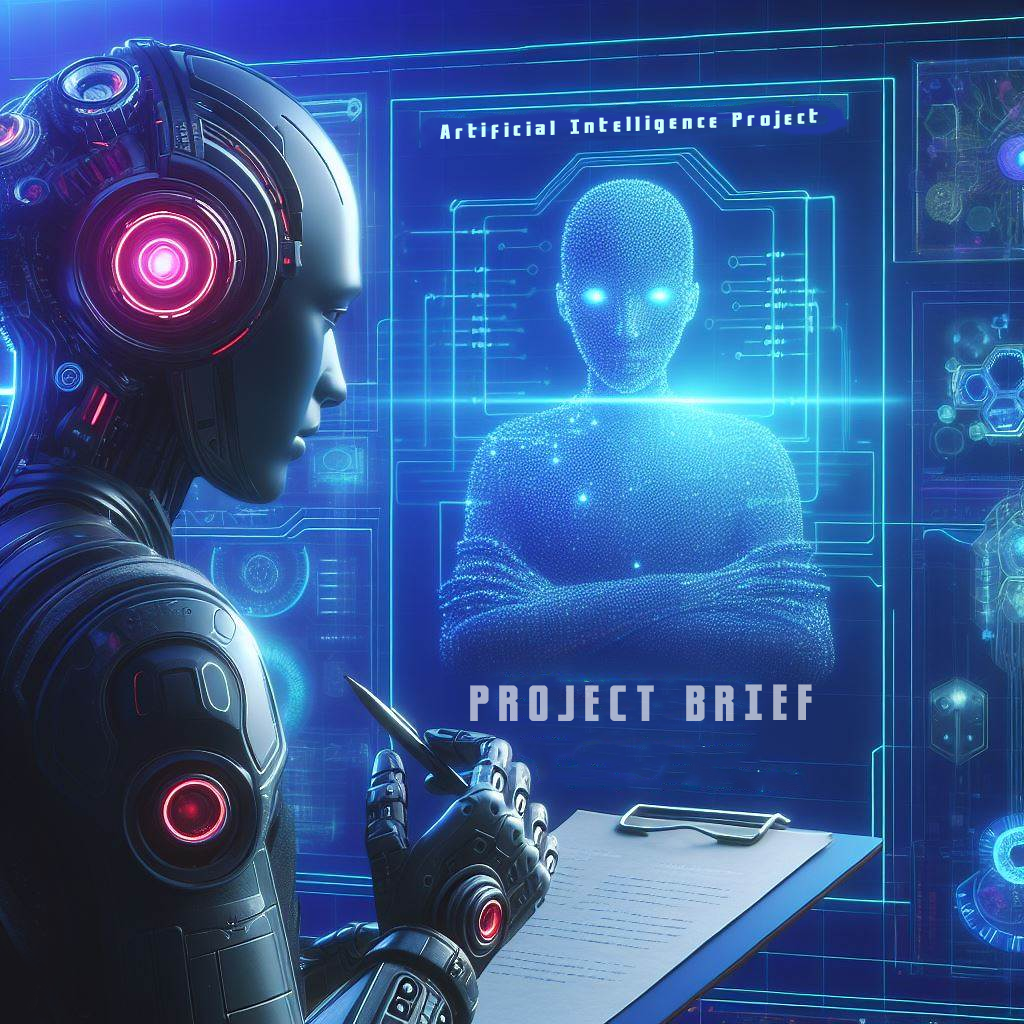How to Make Artificial Intelligence Project
Eessential information with example of how to write project brief and technical requirements
In the rapidly evolving world of technology, creating your own artificial intelligence becomes accessible to a wide range of developers. However, before diving into AI development, it's crucial to define a specific goal or problem you want to solve. In this article, we'll explore the initial steps of this exciting process.

This article provides a comprehensive guide on how to create an artificial intelligence project, covering the initial steps like defining goals, choosing AI types and programming languages, selecting development frameworks, and crafting algorithms. It then details how to put together an effective AI project brief including objectives, scope, timelines, data needs, communication protocols, and testing procedures. Finally, it outlines key technical specifications to provide to AI developers - from system architecture, data ingestion, model details, training procedures, and scalability requirements to security, monitoring, documentation standards and testing. Following this framework sets the stage for a successful AI project build.

In the mid-1950s, people were greatly impressed by the capabilities of computing machines, especially the ability of computers to flawlessly perform multiple tasks simultaneously. Fantastic ideas about thinking machines immediately sprouted in the minds of scientists and writers. It was during this period that the first technologies of artificial intelligence began to emerge.
Research in the field of AI is conducted by studying human cognitive abilities and translating the obtained results into the field of computer activity. Thus, artificial intelligence gathers information from various sources and disciplines, including computer science, mathematics, linguistics, psychology, biology, and engineering. Using machine learning technology based on a vast amount of data, computers attempt to simulate human intelligence.
Main Goals of AI:
- Create analytical systems with intelligent behavior, capable of learning independently or under human supervision, making predictions, and forming hypotheses based on data.
- Implement human intelligence in machines – create assistant robots that can behave like humans: think, learn, understand, and perform assigned tasks.
History of Artificial Intelligence:
The term "artificial intelligence" is attributed to John McCarthy, the founder of programming and inventor of the Lisp language. In 1956, the future Turing Award laureate demonstrated a prototype AI program at Carnegie Mellon University.
The concept of intelligent robots fascinated humanity in the first quarter of the 20th century. In 1924, the renowned writer Karel Čapek staged the play "R.U.R." (Rossum's Universal Robots) in London. The performance astonished the audience, and the word "robot" firmly entered everyday language.
In 1943-45, the foundations for understanding and creating neural networks were laid, and in 1950, Alan Turing published an analysis of an intelligent chess game. The first programming language for artificial intelligence, Lisp, appeared in 1958.
From the 1960s to the 1970s, several scientists demonstrated that computers could understand natural language to a considerable extent. In 1965, the first English-speaking AI assistant, Eliza, was developed. During these years, the field of AI began to attract the attention of government and military organizations in the United States, the Soviet Union, and other countries. The U.S. Department of Defense initiated the virtual street map project, a prototype of GPS, by the 1970s.
In 1969, researchers at Stanford University created Shakey, an AI robot capable of independent movement, perception of some data, and solving simple tasks. Four years later, in 1973, the University of Edinburgh developed Freddie, a Scottish AI representative capable of using computer vision to locate and assemble various models.
In the Soviet Union, AI also developed rapidly. Academics A.I. Berg and G.S. Pospelov created the "ALPÈV LOMI" program in 1954-64, which automatically proved theorems. In the same years, the "KORA" algorithm was developed by Soviet scientists, modeling the human brain's activity in pattern recognition. In 1968, V.F. Turchin created the REFAL symbolic data processing language.
The 1980s were groundbreaking for AI. Researchers developed intelligent machines - cognitive consultants capable of offering solution options, self-learning at a basic level, and communicating with humans in a limited but already natural language.
In 1997, the famous chess program "Deep Blue" was created, defeating the world chess champion Garry Kasparov. Around the same time, Japan began developing a sixth-generation computer project based on neural networks.
Interestingly, in 1989, another chess program, Deep Thought, defeated international grandmaster Bent Larsen. After this man versus machine match, Garry Kasparov stated:
"If an intellectual machine can outplay the best of the best in chess, it means it can write the best music, compose the best books. I can't believe it. When I learn that scientists have created a computer with an intelligence rating of 2800, equal to mine, I will challenge the machine to a chess match to defend the human race."
AI Project Brief Example
This table serves as an example brief for an artificial intelligence project, outlining the key components and requirements necessary for successful development and implementation.
| Item | Description |
|---|---|
| Project Name | [Specify the name of the AI system development project] |
| Client | [Specify the company name or client's name] |
| Project Goal | [Describe the main goal of creating the AI system, e.g., image recognition, natural language processing, prediction, etc.] |
| AI Type | [Specify the type of AI: narrow, general, or superintelligent] |
| Programming Language | [Specify the programming language for development, e.g., Python, Java, C++, etc.] |
| Framework/Platform | [Specify the development framework or platform, e.g., TensorFlow, PyTorch, Scikit-Learn, etc.] |
| Algorithms | [List the algorithms to be used, e.g., neural networks, machine learning, etc.] |
| Data | [Describe the data requirements for training the model: types, sources, volume, etc.] |
| Timelines | [Specify timelines for major project stages: data collection, model training, testing, deployment, etc.] |
| Budget | [Specify the project budget and its allocation across major expense categories] |
| Team | [List the key team members and their roles in the project] |
Overview of Building Strong AI: A Comprehensive Guide
-
Define a Specific Goal/Problem to Solve:
First and foremost, determine what you want to achieve with your artificial intelligence. It could be image recognition, task automation, building a recommendation system, or something else. The more precisely you articulate the goal, the easier it will be to choose suitable methods and technologies.
-
Types of Artificial Intelligence to Solve the Problem:
Depending on the task at hand, choose the appropriate type of artificial intelligence. There are three main types of AI:
- Weak artificial intelligence (Narrow AI): Specialized in solving a specific task, such as speech or image recognition.
- Artificial general intelligence: Capable of solving a broad range of tasks, akin to human capabilities.
- Superintelligent AI: Surpasses human intelligence in all aspects.
- Extreme General Intelligence: Able to far exceed human abilities across all domains of knowledge and tasks, not just specific skills.
- Capability for Recursive Self-Improvement: Can rapidly become even more intelligent through techniques like rewriting its own code.
- Autonomous Goal-Setting: Capable of developing complex plans/strategies to achieve objectives.
- Transferable/Generalizable Learning: Ability to transfer and generalize learning and skills to solve a wide array of problems.
- Resource Allocation: Skill at strategically allocating resources to achieve goals.
- Mastery of Language, Reasoning, and Social Skills: Needed to achieve cooperation with people.
In the world of artificial intelligence, Weak AI, or Narrow AI, stands out for its focused task-oriented approach. Unlike General AI, which mimics human intelligence across various domains, Weak AI excels in specific tasks, offering efficiency in applications like spam filters, recommendation engines, and virtual assistants (Siri/Alexa). While it lacks broad cognitive abilities, it proves invaluable for targeted functions. However, it comes with limitations, including the potential for misuse and job displacement. Advocates highlight its benefits, such as data analysis, routine task automation, and productivity enhancement, emphasizing the need for a balanced approach in its integration.
AGI refers to AI systems with human-level intelligence and the ability to perform any cognitive task humans can across domains. It does not yet exist. Current AI excels at specialized, narrow tasks like playing chess or generating images. AGI would involve transfer learning and generalizing across problems. If developed, AGI could match or surpass human intelligence in most areas due to superior data processing. However, issues around responsibility and alignment with human values remain. Experts disagree on if or when AGI will emerge, with estimates ranging from the next decade to never. Recent advances like GPT-3 showcase impressive breadth but still require oversight and fall short of AGI. Potential pathways involve improved neural networks, combinations with rules-based systems, new computing methods like neuromorphic hardware, and infinite computation. Responsible AGI development is crucial but uncertain.
A superintelligent AI system refers to a hypothetical agent that possesses intelligence far surpassing that of the brightest and most gifted human minds. A superintelligent AI would be characterized by capabilities like:
The idea of superintelligent AI systems evokes both awe at their potential capabilities and fear about their impacts if not properly controlled. Thinkers like Nick Bostrom have written extensively about aligning superintelligent systems with human values, in case they are ever created. True superintelligence likely remains far-off, but the impacts could be world-changing. Recent AI advances like AlphaGo and GPT-3 offer glimpses but still fall enormously short of this theoretical threshold of surpassing even the smartest humans across all domains. Responsible development is crucial to make such systems safe and beneficial rather than hazardous.
The choice of type depends on the breadth of tasks you want to address.
-
Choose a Programming Language:
Decide on the programming language for developing your artificial intelligence. In the AI field, the following languages are most popular:
Choosing Tools and Crafting Intelligence
Now that we've set the foundation for your AI project, let's dive into the next crucial steps. We'll guide you through selecting a development platform and crafting intelligent algorithms that will give your AI the necessary smarts.
Select a Development Framework/Platform:
A development framework or platform serves as the toolbox for your AI, offering pre-built tools and functions to simplify your work. Below are a few popular choices:
-
Scikit-Learn
A simple and efficient tool for data analysis and machine learning. Ideal for small to medium-sized datasets, making it great for beginners.

-
PyTorch
A powerful and flexible deep learning framework, renowned for its dynamic computation graph. Excellent for research and experimentation.

-
TensorFlow
Widely used for machine learning and deep learning, known for its scalability. Suitable for both beginners and experienced developers.

Choose a framework that aligns with your project's needs, your familiarity, and the type of AI you're creating.
Write Algorithms to Power the AI Logic:
Algorithms act as the brains of your AI, breathing life into your creation. Different types of AIs require distinct algorithms. Here are a few common ones:
-
Neural Networks
Mimic the human brain's functionality, making them ideal for tasks like image and speech recognition.

-
Deep Learning
A subset of machine learning involving neural networks with many layers, particularly effective for complex tasks.

-
Machine Learning Algorithms (e.g., Decision Trees, Random Forests, SVM)
Depending on your AI's purpose, classical machine learning algorithms are useful for tasks like classification and regression.

The choice of algorithm hinges on your AI's goal and the nature of the problem you're tackling. Experiment with different algorithms to determine the best fit for your specific project.

Crafting an AI Project Brief: A Guide for Seamless Development
Project Goal:
Embark on your AI project by clearly defining its overarching goal. Are you looking to enhance language understanding, identify and classify images, predict future trends, or explore another facet of AI application? A precise project goal sets the direction for the entire development process.
Project Scope:
Outline the scope of your project, detailing specific features and functionalities aligned with the project goal. Identify any limitations or exclusions that developers need to consider during implementation. This step ensures a shared understanding of the project's boundaries.
Required Technologies:
Specify the vital technologies for project execution, including programming languages, frameworks, libraries, and specialized tools crucial for AI development. Highlight preferred versions and dependencies, providing developers with a roadmap for selecting the right tools.
High-Level Timeline:
Map out a high-level timeline for the project, breaking down major milestones and deadlines. From data collection to model training, testing, and deployment, establish a realistic timeframe that accommodates the intricacies of the AI task.
Data Requirements:
Delve into the specifics of data requirements. Specify data types, formats, sources, and any preprocessing steps necessary. If data privacy or security considerations are pertinent, outline the protocols for developers to adhere to.
Model Evaluation Metrics:
Define the metrics that will gauge the performance of the AI model. Whether it's accuracy, precision, recall, or other relevant metrics, provide clear expectations for the desired outcomes.
Communication Protocols:
Establish communication protocols within the development team. Specify preferred channels for updates, issue reporting, and clarification-seeking. If regular meetings or stand-ups are part of the process, detail their frequency and expected participation.
Documentation Standards:
Define documentation standards encompassing code documentation, model documentation, and any other relevant documentation aiding understanding and future maintenance.
Testing Procedures:
Outline testing procedures for the developed AI model. Specify types of testing such as unit testing, integration testing, and performance testing. Provide guidelines for debugging and issue reporting.
Project Stakeholders:
Identify and list key stakeholders involved in the project, clarifying their roles and responsibilities. This ensures everyone understands their contribution to the project's success.
Budget and Resource Allocation:
If applicable, provide information on the budget and resource allocation. Specify budget constraints and outline how resources, including hardware and software, will be allocated.
Well-crafted AI project brief serves as a roadmap, guiding developers through the intricacies of AI development while fostering collaboration and clarity. By addressing these key components, you set the stage for a successful AI project that meets its goals and exceeds expectations.

Generating Technical Requirements for AI Developers
Defining comprehensive technical specifications is imperative for an AI development team to successfully execute on project goals. This section provides critical guidelines across multiple dimensions – from outlining overall system architecture including components and data flow pipelines to specifying model architecture details like neural network layers and activation functions. It also covers source data ingestion, training procedures, scalability planning to handle increased workloads, integration requirements with external systems or APIs, adequate security controls for data encryption and access, monitoring mechanisms to track performance, documentation standards and testing protocols. By elucidating this technical blueprint covering the full lifecycle of an AI system build, deploy and maintenance, project managers equip engineers to meet core objectives and prepare the solution for real-world implementation.
System Architecture:
Define the overall system architecture for the AI solution. Specify the components, modules, and their interconnections. Provide a high-level overview of how data will flow through the system and identify any external dependencies.
Data Ingestion:
Detail the process of data ingestion into the AI system. Specify the types and sources of data, data formats, and any preprocessing steps required before feeding the data into the AI model.
Model Architecture:
Define the architecture of the AI model. Specify the type of model (e.g., neural network, deep learning model), layers, and activation functions. Include details on any pre-trained models that will be used and the rationale behind their selection.
Training Data:
Outline the dataset to be used for training the AI model. Specify the size of the dataset, its distribution, and any data augmentation techniques applied. If applicable, provide guidelines for handling imbalanced datasets.
Training Procedure:
Describe the training procedure for the AI model. Include details on hyperparameter tuning, optimization algorithms used, and any regularization techniques applied. Specify the metrics used for evaluating the model during training.
Inference Process:
Detail the process of making predictions or inferences using the trained model. Specify input data formats, how real-time or batch predictions will be handled, and any constraints or limitations during the inference phase.
Scalability and Performance:
Define the scalability requirements for the AI system. Specify how the system will handle an increase in workload or data volume. Include performance benchmarks and expected response times for different scenarios.
Integration with External Systems:
Identify any external systems or APIs that the AI solution needs to integrate with. Specify data exchange formats, communication protocols, and security measures for seamless integration.
Security Considerations:
Outline security measures implemented within the AI system. Specify data encryption methods, access control mechanisms, and any measures taken to mitigate potential vulnerabilities.
Monitoring and Logging:
Define the monitoring and logging mechanisms in place for the AI system. Specify the key performance indicators to be monitored, logging formats, and how anomalies or errors will be detected and addressed.
Documentation Standards:
Establish documentation standards for the project. Specify the level of detail required in code comments, model documentation, and any other relevant documentation that aids in understanding and maintaining the project in the future.
Testing Procedures:
Outline the testing procedures for the developed AI system. Specify the types of testing, such as unit testing, integration testing, and performance testing. Provide guidelines for debugging and reporting issues.
Ensure the technical requirements document is clear, concise, and provides all necessary information for AI developers to implement the specified AI project effectively. Aim for a document that facilitates a smooth development process and ensures the successful deployment of the AI solution.
Conclusion
When crafting project documentation like technical specifications and project brief, remember that clear and comprehensive writing is vital for project success. Concisely articulate system architectures, data and model requirements, infrastructure needs, security protocols, testing procedures and more. Well-written documentation equips engineering teams to efficiently build quality solutions. Ambiguous or missing details lead to miscues down the line. Invest time up front in thoughtful specifications to avoid costly confusion later. Document thoroughly and leave no information gaps for developers to fill. Complete and precise documentation saves time, money and headaches through every project stage.
AI cannot replicate the emotional intelligence intrinsic to rallying teams, understanding stakeholders and balancing metrics with soft skills. Rather than replace project managers, AI will become their trusty assistant - crunching numbers so managers can focus on collaboration, communication and strategy essential to project success. Together, humans and AI combine strengths where one falls short of the other. Adopting this complementary framework leads to AI solutions that meet target goals while keeping indispensable human leadership at the helm.

